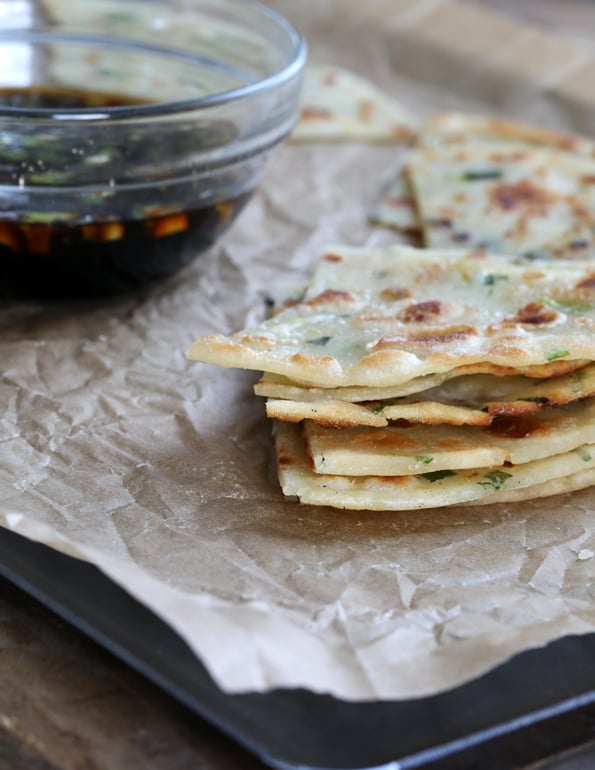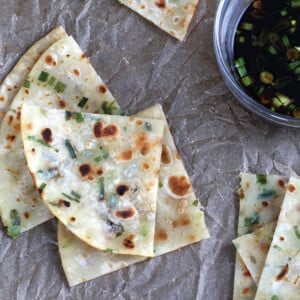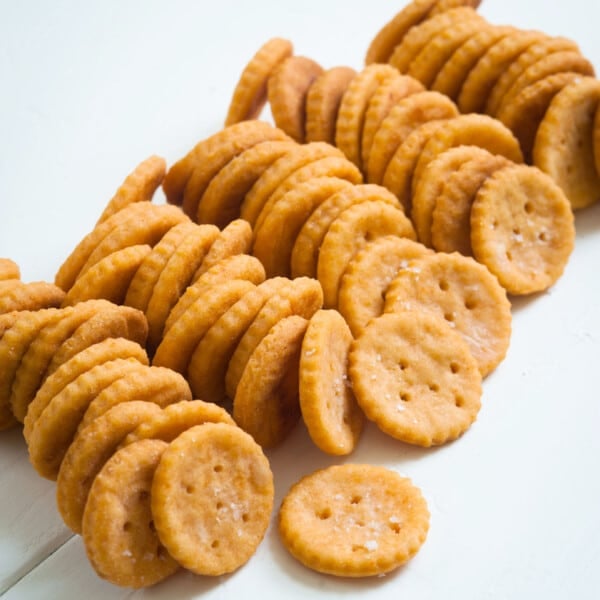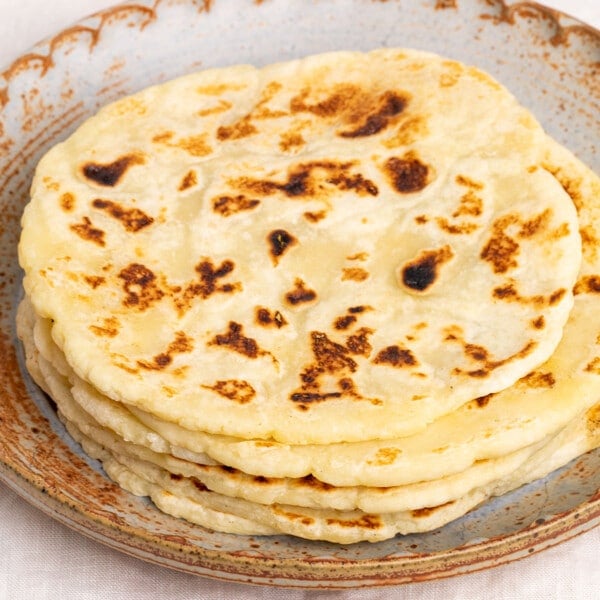This post may contain affiliate links. Please read our disclosure policy.
This recipe for gluten free scallion pancakes with dipping sauce is just like at the Chinese restaurant—but gluten free!

Table of Contents
These flavorful, savory gluten free scallion pancakes are a take on our gluten free won ton wrappers, made in the style of puff pastry, but with similar ingredients to a gluten free tortilla. The raw dough is super easy to work with, and now we can have a gluten free Chinese food favorite back!

Light and flaky, crispy and chewy all at the very same time, scallion pancakes are something I bet you miss from your free-wheeling, gluten-eating days. Well, they're back, baby, and better than ever! I shape them a bit differently, though, than the traditional way. I find they're much easier to work with this way, but still just as flaky.

The traditional way of making scallion pancakes is to roll out the pancake dough into a round, brush it with oil, roll it into a cylinder like a jelly roll, spiral the cylinder into a coil before rolling it out again (and then do it again, but sprinkle scallions after brushing with oil).
I tried it that way, and I found that the dough was much more prone to separating from itself after you roll out the coiled dough. Instead, since the purpose of all the rolling, brushing, coiling and rolling is to create flaky layers of dough separated by a thin layer of oil, I decided to treat the dough like gluten free puff pastry and do the “turns.”
That means just folding the dough like a business letter, and then again into a packet, and rolling out the dough. I find that it stays together much better, and is much less frustrating in general.

The Expandex in the dough makes it incredibly easy to handle. Just make sure you follow the directions carefully, and don't sprinkle the dough with extra flour until right before you roll out the packet of dough for the final time.
That way, it stays together really well. If the dough becomes difficult to handle at all, just chill it in the refrigerator for a few minutes first.
Gluten Free Scallion Pancakes

Equipment
- food processor
- Pastry brush
- 8-inch cake cutter or lid of a pot in similar size
Ingredients
For the scallion pancakes
- 1 ¾ cups (245 g) all purpose gluten free flour blend, plus more for sprinkling (I used Better Batter; please click thru for full info on appropriate blends)
- 1 teaspoon xanthan gum, (omit if your blend already contains it)
- ¼ cup (35 g) Expandex modified tapioca starch, (See Recipe Notes)
- 1 teaspoon kosher salt
- 5 tablespoons (70 g) toasted sesame oil, plus more for frying
- ¾ cup (6 fluid ounces) warm water, (about 85°F) plus more as needed
- 5 scallions, chopped fine
For the dipping sauce
- 3 tablespoons tamari, or gluten free soy sauce
- 3 tablespoons rice vinegar
- ¼ teaspoon dried ginger
- 1 tablespoon honey
- 1 scallion, chopped fine
Instructions
Make the dough.
- Place the flour blend, xanthan gum, Expandex and salt in a medium-size bowl, and whisk to combine well with a separate handheld whisk.
- Transfer the dry ingredients to the bowl of a standard food processor fitted with the steel blade. Add 1 tablespoon of the toasted sesame oil, cover the food processor and pulse twice to begin to combine.
- With the food processor on, drizzle in 3/4 cup of the warm water. The dough should come together. If there are any crumbly bits, drizzle in more water very slowly, continuing to process the dough until it comes together completely.
- Turn the dough out onto a very lightly floured surface and knead until smooth (about 2 minutes).
- Wrap the dough tightly in a large sheet of plastic wrap, and place it in the refrigerator to cool for at least 30 minutes and up to 3 days.
Shape the dough.
- When you are ready to use the dough, divide it into 5 pieces of equal size (each about 3 1/2 ounces).
- Working with one piece of dough at a time (and covering the remaining pieces with a damp towel to keep them from drying out), and without using any additional flour yet, roll the dough into a round about 8-inches in diameter. First “turn.”
- Using a pastry brush and the remaining 4 tablespoons toasted sesame oil, brush the entire surface of the dough with a thin layer of oil.
- Fold the rolled-out dough like you would puff pastry, like a business letter (by thirds, into a rectangle–see photo), and then one short end over another into a packet (see photo). Press the packet of dough down firmly with your hands, and then reroll the dough into a round about 8-inches in diameter. Second (and final) “turn.”
- Once again using a pastry brush and the sesame oil, brush the entire surface of the dough with a thin layer of oil, and scatter about 2 tablespoons of chopped scallions evenly over the surface, and repeat the folding process into a packet, just as before. Once more, press the packet down firmly with your hands.
- Now, sprinkle the dough liberally with flour, and roll the dough one final time into an 8-inch round, sprinkling with flour as necessary to prevent sticking.
- Trim the rough edges for a smooth circle (I used an 8-inch cake cutter, but you can use a pizza or pastry wheel), and set the dough aside. Repeat with the remaining pieces of dough.
Fry the pancakes.
- Heat about 1/4-inch of toasted sesame oil in a 12-inch, heavy-bottom skillet until shimmering.
- Place the pancakes, one a time, in the oil and fry on each side until lightly golden brown (3 to 4 minutes total).
- Remove from the oil and place on a paper towel-lined plate to drain. Stack the pancakes and slice them in a stack into 4 wedges each.
Make the dipping sauce.
- In a small bowl, place the tamari, rice vinegar, ginger and honey and mix to combine well.
- Add the chopped scallions, and serve with the hot scallion pancake wedges.
Make-ahead options.
- The unshaped scallion pancake dough can be stored, tightly wrapped, in the refrigerator for at least 3 days before shaping.
- The shaped, but unfried, pancakes can be stacked, wrapped well and stored in the freezer until ready to use. Defrost overnight in the refrigerator before frying.
- For best results, serve immediately after frying. For second-best results, heat the cooled, already-fried pancakes in a dry cast-iron skillet before serving.
Notes
Nutrition information is automatically calculated, so should only be used as an approximation.














Hi, we are Americans living in Peru for the next year. I just bought some tapioca starch here but have no way of knowing if it is regular or altered. (I was lucky just to get some, actually, having searched at several stores with no tapioca starch at all.) When you say the Ultratex3 is available, is it a brand that is packaged or what? Any chance I can use this recipe with regular tapioca starch? I did buy your bread cookbook and it is waiting for me and our return to Minnesota. I think it will make a huge difference for my GF and celiac impacted family. Thanks! Keturah
Well, I found this FAQ https://glutenfreeonashoestring.com/about/gluten-free-bread-troubleshooting-faqs/#15. But that doesn’t explain how you can get Ultratex here (unless it is paying psycho high shipping fees). In which case we may use limp along with our homemade corn flour bread bars until we return home and can buy these things more easily. :)
Hmm. I thought I replied, but I don’t see it. I did google before asking. I didn’t see exactly what I was looking for. The bag had a strong chemical odor when I opened it up. So I am just trying to figure out exactly what chemical they are using. And I am trying to decide if this processed ingredient is worth it for me to use for food for my family.
What can you use instead of Expandex?
YAY!!!! One of the things that I missed the most was scallion pancakes. Thank you, thank you, thank you!!! You rock.
Lovely, I can’t wait to try these! My order of Expandex and Now is waiting at the border for me to pick up this weekend! Yeah!
Thank you so much for chiming in, Karlie!!
Is it wrong to say “I love you” so soon, John?
I tried ordering Expandex online but was unsuccessful….is it not available in Canada? I ordered the Ultratex yesterday and can hardly wait til it arrives so I can do some serious baking! Love your books and the blog….found them just as I was about to give up on GF baking. Thanks a bunchh, Nicole. I can hardly wait for the next book.
Oh, bless you. These look fantastic, and I can’t wait to make them!
P.S. Your extra-flaky buttermilk biscuits from GFOAS Bakes Bread are freaking fabulous. The layers! I cannot get over THE LAYERS! I’ve baked them three times and am about to go for the fourth!
OXO
Go for four, Allison! :)
This looks so good. I can’t wait to try it. I have a question. What are the ingredients in Expanded?? I purchased a package and it doesn’t tell me. How is it different than regular tapioca starch?
Yes, Kberly. It is different than tapioca starch. Please see the Bread FAQs, particularly FAQ#16.
I have looked at your FAQ. I am wondering what is the process or what do they add to make it Expandex. My packages doesn’t have a list of ingredients.
It’s a patented process where they modify the starch. It’s not possible to know exactly what they do because it’s protected. It IS 100% tapioca starch though, the but structure of the proteins has been altered. This is the generic version of how food starches are modified. http://blog.bobsredmill.com/featured-articles/modified-food-starch-demystified/
Kberly, if you can’t find your answer in the FAQ or you want more “scientific-y” info you should try the internet machine (it’s amazing what you can find!).
My first hit came up with this: http://glutenfreecooking.about.com/od/glutenfreeingredien2/p/expandex.htm
Which provides some info. In brief, Expandex is a “modified” tapioca starch. It starts out like the off the shelf stuff but it is modified to change the molecular structure.
Again, this was the first hit. There are hundreds more.
Happy hunting,
John L
Kberly, Expandex is a modified tapioca starch. How it is modified is proprietary information, unfortunately.